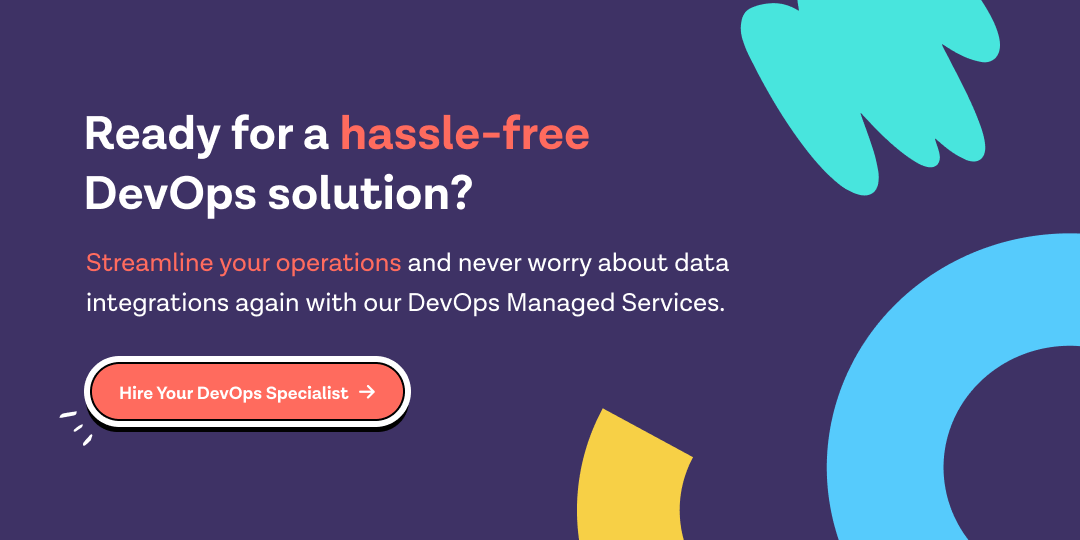Implementing DevOps practices within your organization can significantly improve software development, delivery, and overall operational efficiency. However, successful DevOps implementation requires a well-defined implementation plan.
Enable your team to deliver high-quality software faster and with greater reliability. Let's dive into the key considerations and best practices for creating a successful DevOps implementation plan.
Assess DevOps Infrastructure
Before diving into the implementation process, assessing your existing DevOps infrastructure is crucial. This step involves evaluating your current software development practices, tools, and workflows. Here are a few key aspects to consider.
- Software Development Lifecycle: Examine your current development lifecycle, from requirements gathering to deployment and maintenance. Identify any bottlenecks, inefficiencies, or gaps in the process that could be optimized through a DevOps transition.
- Collaboration and Communication: Assess the level of collaboration and communication among your development, operations, and other relevant teams. Look for opportunities to improve communication channels, enhance collaboration, and foster a culture of shared responsibility.
- Tools and Technologies: Review the tools and technologies you currently use for software development, testing, deployment, and monitoring. Determine if these tools are aligned with DevOps principles and how they can be integrated into your DevOps workflow.
- Infrastructure and Automation: Evaluate your infrastructure capabilities and automation processes. Consider the availability of infrastructure as code (IaC) tools, deployment automation, configuration management, and continuous integration and deployment (CI/CD) pipelines.
By thoroughly assessing your existing DevOps infrastructure, you can identify areas for improvement and build a solid foundation. This assessment will guide your decision-making process and help determine your DevOps implementation's specific needs and requirements.
Determining Your DevOps Needs
Once you have assessed your DevOps infrastructure, you must determine your specific needs and goals for implementing DevOps. This involves identifying the areas where DevOps practices can bring the most value and addressing any challenges or pain points. Here are some key considerations.
- Business Objectives: Align your DevOps implementation with your overall business objectives. Identify the specific outcomes you aim to achieve, such as improved software quality, faster time to market, or enhanced customer satisfaction.
- Pain Points: Identify the pain points in your current software development and delivery process. Are bottlenecks impacting your team's productivity or hindering the software delivery cycle? Understanding these pain points will help you prioritize and address them.
- Cultural Shift: DevOps is not just about tools and technologies; it also involves a cultural shift within the organization. Consider the level of collaboration, communication, and shared responsibility among your teams. Determine if there is a need for a cultural transformation to foster a DevOps mindset and successful implementation.
- Skillset and Training: Assess the skills and expertise of your development and operations teams. Identify any gaps in knowledge and determine if additional training or upskilling is required to embrace DevOps practices effectively. Consider providing resources and training opportunities to equip your teams.
You can create a roadmap for your DevOps implementation plan by determining your needs and goals. This will enable you to prioritize initiatives, allocate resources effectively, and set realistic timelines for achieving your desired outcomes. Remember, DevOps is a journey, and understanding your needs will help you chart a course toward a successful implementation.
Create a DevOps Implementation Strategy
With a clear understanding of your DevOps infrastructure and identified needs, it's time to create a comprehensive implementation plan. This plan will serve as a roadmap for executing your DevOps initiatives and driving organizational change. Here are the key steps to consider.
- Set Clear Goals: Define clear and measurable goals for your DevOps implementation. These goals should align with your organization's overall objectives and address the specific needs you identified earlier. For example, your goals might include reducing deployment time, increasing automation, or improving collaboration between development and operations teams.
- Break it Down: Break your implementation plan into smaller, manageable tasks and milestones. This helps to ensure a step-by-step approach and provides a clear path forward. Consider prioritizing tasks based on their impact to optimize your efforts.
- Identify Tools and Technologies: Assess the tools and technologies supporting your DevOps practices. Look for solutions that align with your organizational goals and requirements. This may include continuous integration and delivery tools, infrastructure automation tools, configuration management systems, and monitoring tools.
- Define Processes and Workflows: Establish streamlined processes and workflows that promote collaboration, automation, and continuous improvement. Define how code will be developed, tested, and deployed. Implement practices such as version control, code reviews, automated testing, and continuous integration. Identify areas where automation can be applied to reduce manual effort and ensure consistency.
- Resource Allocation: Determine the resources required for your DevOps implementation, including personnel, infrastructure, and budget. Allocate resources effectively to support your plan and ensure the necessary expertise and tools are available. Consider whether you have the internal capabilities to handle the implementation or if outsourcing to a DevOps service provider is a better option.
- Communication and Training: Communicate your DevOps implementation plan to all relevant stakeholders and teams. Ensure that everyone understands the goals, processes, and expectations. Provide training and support to help team members acquire the necessary skills and knowledge for successful adoption.
- Measurement and Evaluation: Define key performance indicators (KPIs) to measure the success of your DevOps implementation. Continuously monitor and evaluate your progress against these metrics to identify areas for improvement and make necessary adjustments to your plan.
- By following these steps and creating a well-defined implementation plan, you can effectively guide your organization's DevOps journey.
Remember, a successful DevOps implementation plan is adaptable and evolves. Regularly review and refine your strategy based on feedback, lessons learned, and changes in your organization's needs. With a well-executed implementation plan, you can drive efficiency, collaboration, and innovation throughout your software development and delivery processes.
Developing a Roadmap
When developing a roadmap for your DevOps implementation, it's essential to break down the plan into manageable phases. This approach allows for a structured and organized implementation process. Consider dividing your implementation plan into logical stages, such as infrastructure setup, tool selection and integration, process automation, and continuous integration/continuous delivery (CI/CD) pipeline development.
Prioritizing key initiatives and timelines
Prioritization is crucial when developing a DevOps roadmap. Identify the key initiatives that will have the most significant impact on your organization's operations and goals. Consider factors such as business needs, pain points, and potential benefits. Determine the timelines for each initiative, considering the complexity of the task, resource availability, and dependencies on other projects.
Defining key milestones
To ensure progress and measure success, define key milestones and deliverables for each phase of your DevOps implementation. Milestones mark important stages of progress, while deliverables are tangible outcomes demonstrating the completion of specific tasks or objectives. By defining clear milestones and deliverables, you can track the implementation progress and ensure alignment with your goals.
Creating a realistic timeline and resource allocation plan
Developing a realistic timeline and resource allocation plan is critical for the success of your DevOps implementation. Consider the scope of each phase, the availability of resources, and any potential constraints or dependencies. Ensure that the timeline allows for thorough testing, evaluation, and adjustments. Allocate resources effectively, considering the skills and expertise required for each phase, and ensure that resources are adequately trained and prepared for their roles.
You can effectively guide your DevOps implementation journey by developing a well-structured roadmap with manageable phases, prioritizing key initiatives, defining milestones and deliverables, and creating a realistic timeline and resource allocation plan. This roadmap is a valuable reference point, helping you stay on track, measure progress, and achieve your DevOps goals.
Joke Break
Why did the DevOps engineer bring a ladder to work?
To reach the cloud!
Yeah, that was bad. But you didn’t come here for the joke (I hope), so let’s get back to business.
Establishing Communication and Collaboration
Promoting a culture of collaboration and knowledge sharing
Promoting a culture of collaboration and knowledge sharing within your organization is crucial to ensure a successful DevOps implementation. Encourage teams to work together, share their expertise, and learn from each other. Foster an environment that values open communication, encourages constructive feedback, and promotes collaboration across departments. This collaborative culture enables teams to leverage their collective knowledge and experience, improving productivity and innovation.
Identifying stakeholders
Identifying key stakeholders is essential for effective communication and collaboration during your DevOps journey. Identify individuals and teams directly involved in or affected by the implementation.
Establish clear communication channels to ensure smooth information flow and timely updates. Consider using tools like team collaboration platforms, project management software, and regular meetings to facilitate communication and keep stakeholders informed about progress, challenges, and decisions.
Encouraging collaboration between cross-functional teams
One of the core principles of DevOps is breaking down silos between development and operations teams. Encourage forming cross-functional teams where developers, operations staff, and other relevant stakeholders work together on shared goals.
You can foster collaboration by organizing joint meetings, workshops, and training sessions. Collaborating brings together various perspectives and expertise. This leads to more efficient problem-solving and quicker decision-making, improving efficiency.
Effective communication and collaboration enhance team dynamics and enable seamless coordination and alignment throughout DevOps.
Implementing Tools and Automation
Evaluating and selecting appropriate tools for your DevOps stack
Choosing the right tools for your DevOps implementation is crucial for streamlining processes and maximizing efficiency. Evaluate different tools available for each stage of the software development lifecycle, such as continuous integration, automated testing, and deployment. Consider factors like functionality, compatibility, ease of use, and scalability. Select tools that align with your organization's requirements, budget, and technical infrastructure.
Implementing automation processes
Automation plays a crucial role in DevOps by reducing manual effort, improving consistency, and accelerating the software delivery cycle. Implement automation processes for building, testing, and deploying applications. This involves creating automated workflows, scripts, and configurations that eliminate repetitive tasks and minimize the risk of human error. By automating these processes, you can achieve faster and more reliable software releases, enabling teams to focus on higher-value activities.
Integrating tools and technologies
Effective collaboration among different teams and tools is essential for successful DevOps implementation. Integrate your chosen tools and technologies to enable seamless data sharing, communication, and collaboration. For example, connect your version control system with your build automation tool or integrate your testing framework with your deployment pipeline. By integrating these tools, you can achieve end-to-end visibility and facilitate efficient collaboration across the entire software development lifecycle.
Training teams on new tools
Introducing new tools and technologies requires proper training and support to ensure effective use and adoption. Provide comprehensive training programs to familiarize teams with the tools and automation processes. Offer hands-on workshops, documentation, and resources to help teams understand the benefits and best practices.
Encourage knowledge sharing and provide ongoing support to address any challenges or questions during the adoption process. Investing in training and fostering adoption empowers teams to maximize the tool’s potential and productivity.
Continuous Improvement and Iteration
Establishing feedback loops
Continuous improvement is a fundamental principle of DevOps. Establish feedback loops to gather insights and feedback from stakeholders, including developers, operations teams, and end-users. This can be done through regular meetings, retrospectives, and surveys.
Actively listen to feedback and identify areas for improvement in your DevOps practices, processes, and tools. By embracing feedback, you can drive continuous improvement and enhance the overall effectiveness of your DevOps implementation.
Collecting and analyzing metrics
Metrics play a vital role in evaluating the effectiveness of your DevOps practices and identifying areas for optimization. Define key performance indicators (KPIs) that align with your business objectives, such as deployment frequency, lead time, and mean time to recovery. Collect relevant data and analyze it to gain insights into your software delivery pipeline's efficiency, quality, and reliability. Use these metrics to identify bottlenecks, track progress, and drive continuous improvement.
Encouraging a culture of experimentation and innovation
DevOps thrives in an environment that encourages experimentation and innovation. Foster a culture that values and rewards new ideas and enables teams to explore innovative approaches. Provide opportunities for individuals to experiment with new tools, technologies, and processes.
Embrace a fail-fast mentality where failures are seen as learning opportunities. By fostering a culture of experimentation and innovation, you can drive continuous improvement and unlock new possibilities for your DevOps practices.
Iterating on the DevOps implementation plan
No DevOps implementation plan is perfect from the start. It's essential to iterate and refine your plan based on feedback and lessons learned throughout the implementation journey.
Regularly review the effectiveness of your practices, processes, and tools. Incorporate stakeholder feedback and make necessary adjustments to address any gaps or challenges. Embrace an iterative approach that allows you to continuously evolve and adapt your DevOps implementation plan based on real-world experiences.
This iterative approach allows you to enhance your DevOps practices, optimize processes, and drive innovation, ultimately enabling your teams to deliver higher-quality software and achieve greater operational efficiency.
Consider DevOps Outsourcing
While implementing DevOps practices can bring significant benefits, it can also be a lot of work. Outsourcing DevOps work to a specialized service provider is also a strategic option worth considering. Here are some key aspects to explore when deciding whether to outsource your DevOps initiatives:
- Access to Specialized Expertise
- Cost Efficiency and Scalability
- Focus on Core Business Priorities
- Accelerated Time-to-Value
- Risk Mitigation
- Continuous Improvement and Innovation
When considering outsourcing DevOps work, conducting thorough research and due diligence is crucial. Evaluate potential service providers based on their expertise, track record, and the alignment of their offerings with your organization's goals. Consider factors such as communication, collaboration, and cultural fit to ensure a successful partnership.
Assessing the benefits and challenges of outsourcing DevOps
Outsourcing DevOps work can offer several benefits, such as accessing specialized expertise, reducing costs, and achieving scalability. However, it's essential to assess the benefits and challenges associated with outsourcing carefully. Consider factors like the complexity of your DevOps environment, the level of control you need over processes, and the potential impact on internal team dynamics.
Identifying tasks or processes to outsource
Not all DevOps tasks or processes are suitable for outsourcing. Evaluate your DevOps infrastructure and identify areas an outsourced team can manage effectively. Consider tasks like infrastructure management, monitoring, security, and release management. Determine if these tasks can be seamlessly transferred to an external provider while maintaining the desired level of control and quality.
Evaluating potential DevOps service providers and selecting the right partner
When considering outsourcing DevOps work, thoroughly evaluating potential service providers is crucial. Look for providers with a strong track record in DevOps, experience in your industry, and a demonstrated understanding of your specific needs.
Assess their expertise, technical capabilities, and the quality of their services. Consider factors like their approach to collaboration, ability to scale with your organization's growth, and commitment to security and compliance. Choose a partner that aligns with your goals and can provide the necessary support to achieve your DevOps objectives.
Establishing clear expectations and communication channels
Clearly define roles, responsibilities, and deliverables. Establish service-level agreements (SLAs) that outline performance metrics and expectations. Regularly communicate with the outsourced team to address concerns, provide feedback, and align project goals and timelines. Open and transparent communication will help foster a collaborative and productive relationship with the outsourced DevOps team.
It's important to note that outsourcing DevOps work does not mean relinquishing control entirely. Effective collaboration and regular communication with the service provider is essential to align goals, manage expectations, and maintain transparency throughout the engagement.
Conclusion
Creating a DevOps implementation plan is critical to building a more efficient and collaborative software development and operations environment. By following the key steps outlined in this guide, you can establish a solid foundation for successful DevOps adoption within your organization.
Throughout this process, it is essential to remember to adapt this guide to your organization's unique needs. Tailor your implementation plan to your specific needs, challenges, and goals. Continuously assess and refine your strategies to ensure they remain relevant and effective as your organization evolves.
Implementing an effective DevOps strategy requires commitment, collaboration, and continuous improvement. Embrace the cultural changes and foster an environment that promotes teamwork, knowledge sharing, and innovation. Encourage cross-functional teams to work together seamlessly, break down silos, and align their efforts towards common objectives.
As you embark on your DevOps journey, remember that the benefits go beyond improved software development and operations. DevOps can transform your entire organization by enabling faster time-to-market, enhanced quality and reliability, and increased customer satisfaction.
Now is the time to take the necessary steps toward implementing an effective DevOps strategy. Evaluate your current processes, assess your infrastructure, and determine your needs and priorities. Engage stakeholders, foster collaboration, and implement the necessary tools and automation.
Consider working with Talentcrowd to unlock the full potential of your organization's software development and operations.




